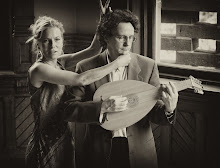This still life with rotten fruit and musical instruments was taken at today's rehearsal for the Apt for Voices and Violins. 8PM, Sat. Oct. 8th at Heliconian Hall, 35 Hazelton Ave. near Bay Subway in Toronto. Tickets $25 and 20. Doors open at 7:30. Here's the program:
Welcome black Night John Dowland (1563-16 26)
Though Amarillis William Byrd (1540-1623)
Paduan – Aria Dowland, arr. Thomas Simpson (1582-c. 1630)
La Sirena Thomas Morley (1558-1602)
Die not before thy day Dowland
Ambroses Pavin Ambrose Lupo (d.1591)
Galliard to the pavin before
What if I never speede Dowland
Lachrimae Pavaen Dowland, arr. Johann Schop (c. 1590-1667)
Ne reminiscaris Domine John Wilbye (1574-1638)
When to her lute Corinna sings Thomas Campion (1567-1620)
Weepe you no more Dowland
Ronda – Represa Anon. from the Lumley Partbooks
Brandenberges – Represa
Intermission
Lady if you so spight me Dowland
Sorrow come Dowland, arr. William Wigthorpe (c.1570-1610)
La Rondinella Morley
Pavana Bray, Volta Byrd, arr. Francis Cutting (c1550-1596)/Anon.
Sweet stay a while Dowland
Pavana – Gallyard –Dance Anon. from the Lumley Partbooks
Fuga Dowland
If fluds of teares Dowland
Come to mee grief forever Byrd
Delacourt Pavan Anon.
Markantonyes Gallyard Mark Anthony Galliardello (d. 1585)
Cease these false sports Dowland
Hallie Fishel - Soprano
Christopher Verrette - Violin and viola
Edwin Huizinga - Violin
Eleanor Verrette - Viola
Laura Jones - Bass violin
John Edwards - Lute
A string band arrived in England in the reign of Henry VIII. Wind instruments had been played in ‘choirs’, corresponding to soprano, alto, tenor and bass voices for some time, but the application of this concept to stringed instruments had first occurred to Isabella d’Este and her sister-in-law Lucrezia Borgia in Mantua and Ferrara respectively. The string playing families, such as the Lupos and the Galliardellos, who turned up at Henry’s court appear to have been Jews who were escaping resurgent persecution in Italy.
The word ‘viol’ seems to have been used in Elizabethan and Jacobean times for both the drop-shouldered, 6-string ‘da gamba’ family and that family of stringed instruments we now see in symphony orchestras. The print of Morley’s ‘Consorts Lessons’ for example has ‘treble viol’ on one of the partbooks, but pictures of that kind of ‘broken’ consort always show a treble violin played ‘da braccia’, on the arm. Though the repertoires of viol and violin were largely interchangeable there was a social difference between players of the two instruments. Though the viol increasingly took over the position of the lute as the instrument of the amateur, the violin was always played by professionals, and was the main ensemble for courtly dance music.
The Epistle to the Reader of Byrd’s Psalmes, Sonets, & songs of sadnes and pietie tells us that several of the songs in that collection were ‘originally made for Instruments to expresse the harmony’ and, though all the parts are texted for maximum performance options (and sales to partsong singers), he helpfully labels the melody ‘the first singing part’ in those songs where instruments are expected. As well as some of these pieces from Byrd’s publication we present some from manuscript sources. We present a consort song arrangement of Dowland’s lute song Sorrow stay with its secular words, though the manuscript of the string version gives a sacred contrafactum where the singer rises to heaven, rather than falls into the pit of despair with Dowland. Ne reminiscaris is a setting of the antiphon of a penitential psalm. It appears that string consorts were often used in chapels, perhaps where organs were too expensive or mice had chewed the leather bellows.
What we think of as ‘lute ayres’ were commonly printed with optional four-part versions for voices, or, as the title page of Dowland’s Third Book of Songs says ‘to sing to the lute, orpharion or viols.’ Again, maximum flexibility for performance is offered.
In the early 17th century England began exporting string players back to the European continent. Dowland, Thomas Simpson and William Brade all worked at the Danish court where Johann Schop was also a violinist. (The ceiling painting on the cover of our brochure is from a Danish palace of this period. Could that be Dowland peeking over the balcony?) Simpson’s arrangements of Dowland with continuo and the string quartet scoring with two violins rather than plural violas represent the beginnings of the baroque, though Dowland did offer one galliard ‘with two trebles’ in his own collection of string music.
Ne reminiscaris Domine
Remember not, Lord, our offences, neither those of our fathers:
and do not wreak vengeance for our transgressions.
Spare, Lord, spare your people, whom you redeemed with your precious blood:
lest you be angry with us for ever.




No comments:
Post a Comment